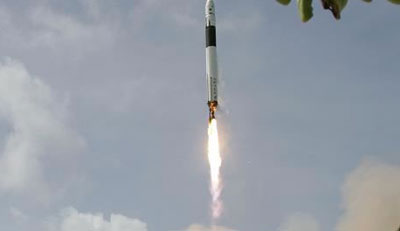|
|
 SpaceX’s Falcon 1 lifts off at the beginning of its ill-fated mission on Friday. (credit: SpaceX) |
First flight success isn’t the whole story
by Tom Hill
Monday, April 3, 2006
In the wake of the Falcon 1 failure on the 24th of March, Dwayne Day’s essay “Our rockets always blow up” (The Space Review, March 27, 2006) makes a valid point that not all orbital rockets fail on their first launch. In fact, the list he uses shows that the first launch success rates are actually more than 50%, though not by much. He simplifies the argument a little too much, however, by drawing no distinction between rockets that were developed from scratch, such as Falcon, and those derived from other vehicles. Getting a long-range rocket with a payload to fly is hard, getting into space is slightly harder (it could be easier, if we worked at it), but getting into orbit with all-new equipment from a company new to the business is rare and much harder.
Why is this important? Because anyone who compares the fact that Falcon 1 failed on its first orbital flight while the Atlas B succeeded on its first flight is not giving the SpaceX team enough credit. The Atlas B orbital launcher was an improvement on the Atlas A intercontinental ballistic missile, and the Atlas A took three tries before it got a flight right. The Jupiter C orbital launcher, which put America’s first successful satellite into orbit, was based on the Redstone intermediate range ballistic missile, which nicely absorbed flight failures in its development program, paving the way for Jupiter C.
Let’s revisit the successful list from Dr. Day’s essay and see if prior flight experience of similar rockets or a comination of previously working rockets may have contributed to some successful first flights:
Sputnik (Derived from the R-7 ICBM)
Jupiter C (Derived from the Redstone IRBM)
Juno 3 (Derived from Jupiter IRBM)
Atlas B (Derived from the Atlas A ICBM)
Saturn 1 (Derived from the Redstone and Jupiter IRBMs)
Titan 2
Kosmos11k65 (Derived from the R-14 Ballistic Missile)
Proton
Diamant 1
Saturn 5
Long March 1 (Derived from the DF-3 IRBM)
Scout D
Ariane 1
Shuttle
Shaviyt
Pegasus
Start-1
H-II
Taurus (Pegasus upper stages, Peacekeeper ICBM first stage)
Rockot
M-5
Shtil
Minotaur (Pegasus upper stages, Minuteman ICBM first stage)
Atlas 5
Delta 4
So more than a third of the rockets listed here have easily traceable pedigrees, meaning flight experience for both the hardware and the teams that work on it. Such a pedigree is not a guarantee for success, but it likely improves the odds. The Chair Force Engineer discusses other examples.
Count me as one of the many who attributed the failure of Falcon 1 to “The first flight blues” afflicting many rockets, and I was surprised that the percentage of successful first flights (pointed out in Dr. Day’s article) was higher than I thought. While a first flight isn’t a guaranteed failure, the number of items in a rocket that can’t be tested together until a booster leaves the ground makes a successful first flight something to brag about. High flight rates—at low cost with continuing success—is the important goal to shoot for, however, and SpaceX still has that potential.
The author wishes to thank Mark Wade and his Encyclopedia Astronautica for data on the boosters and their histories.
Tom Hill is a rocket scientist, though he stopped bringing it up socially because of the weird turns that conversations usually take after his line of work is mentioned.
|
|
